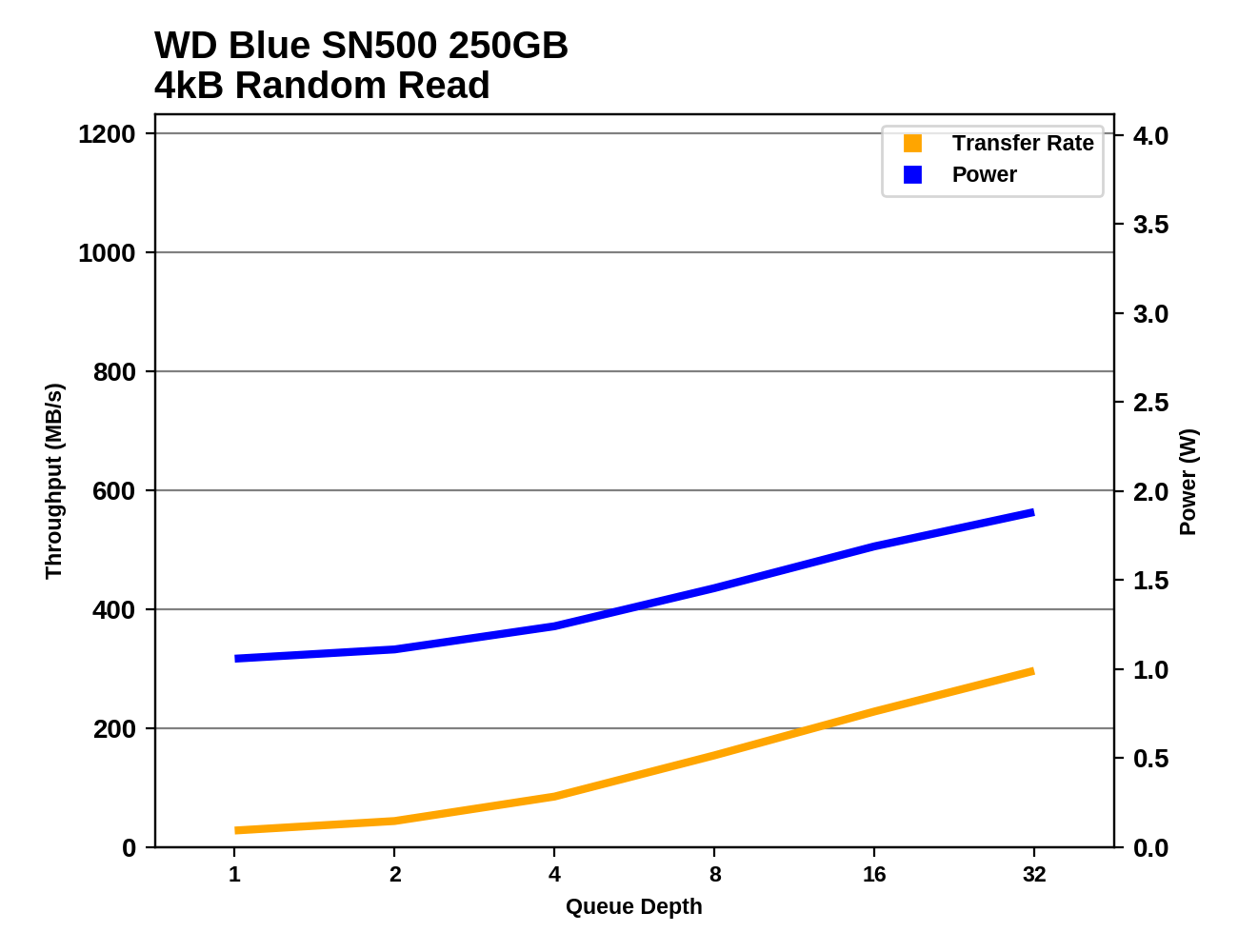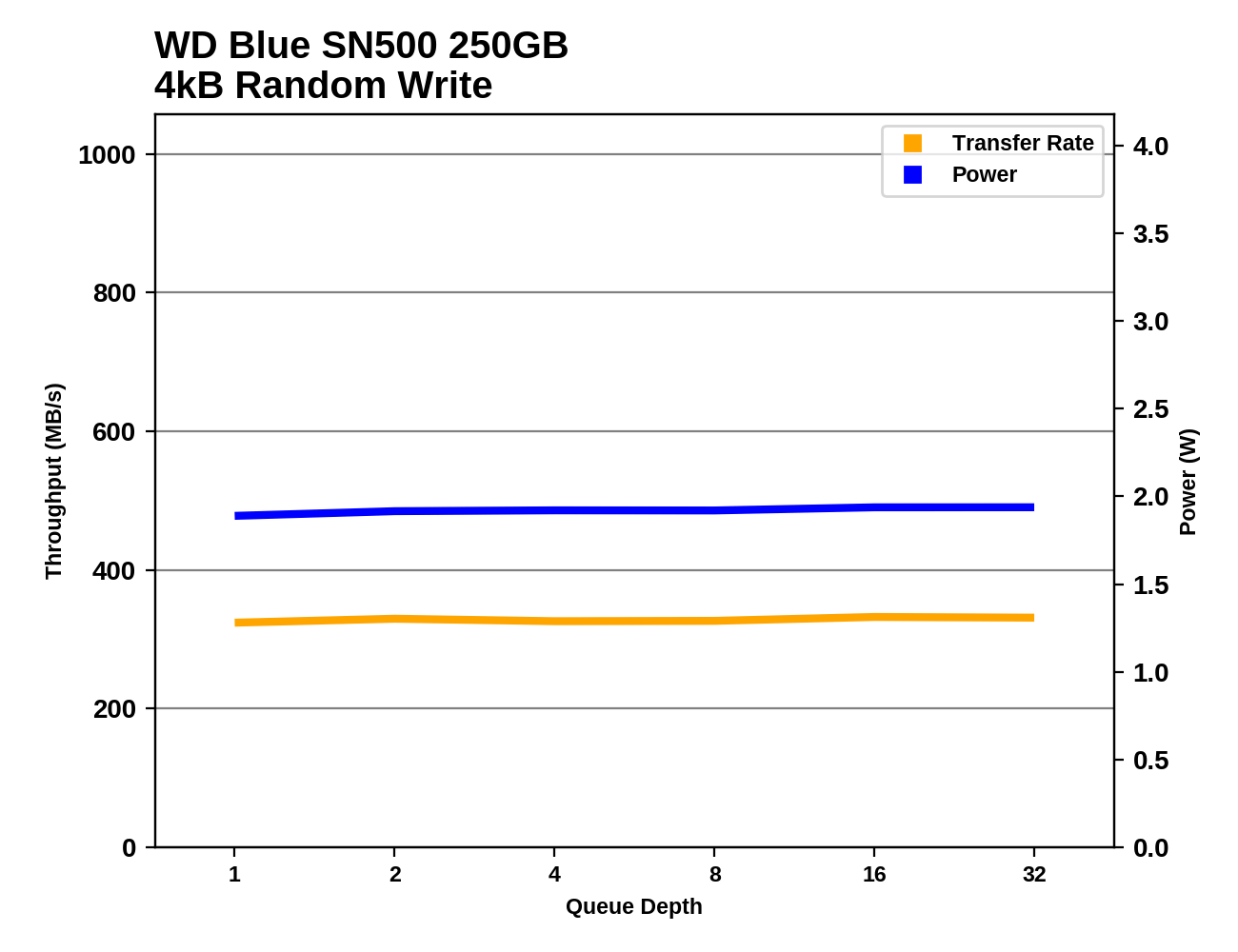The Western Digital WD Blue SN500 SSD Review: Moving The Mainstream To NVMe
by Billy Tallis on April 19, 2019 9:30 AM ESTRandom Read Performance
Our first test of random read performance uses very short bursts of operations issued one at a time with no queuing. The drives are given enough idle time between bursts to yield an overall duty cycle of 20%, so thermal throttling is impossible. Each burst consists of a total of 32MB of 4kB random reads, from a 16GB span of the disk. The total data read is 1GB.

This test is confined to a 16GB portion of the drive, but the WD Blue SN500 requires more spatial locality than that to offer its best random read performance, due to its DRAMless design with only a small on-controller buffer and no HMB support. The SN500 ends up as the worst-performing NVMe drive in the bunch and only beats the Toshiba TR200 DRAMless SATA SSD.
Our sustained random read performance is similar to the random read test from our 2015 test suite: queue depths from 1 to 32 are tested, and the average performance and power efficiency across QD1, QD2 and QD4 are reported as the primary scores. Each queue depth is tested for one minute or 32GB of data transferred, whichever is shorter. After each queue depth is tested, the drive is given up to one minute to cool off so that the higher queue depths are unlikely to be affected by accumulated heat build-up. The individual read operations are again 4kB, and cover a 64GB span of the drive.

On the longer random read test, the SN500 still fares poorly, but now that the test span has widened to 64GB, the Toshiba RC100's host memory buffer is also not large enough, and the RC100 falls behind the SN500.
 |
|||||||||
| Power Efficiency in MB/s/W | Average Power in W | ||||||||
The WD Blue SN500 and Toshiba RC100 draw significantly less power than any of the other NVMe drives during the random read test, with a low-QD average of a bit over 1W. This translates to a good but not great efficiency score for the SN500: the larger drives with much better performance have considerably better efficiency, as does the Samsung 850 EVO that provided 60% better performance without drawing any more power.
 |
|||||||||
All of the 250GB-class SSDs have limited potential for performance increases at high queue depth compared to higher capacity drives, but the SN500's performance scaling is poor even within its capacity class. Power consumption starts around 1W at QD1 and stays below 2W even at QD32, while the high-end NVMe drives start out above 2W and climb from there.
The random read performance of the WD Blue SN500 never gets out of SATA SSD territory, but the power efficiency is pretty good for the performance it does provide, especially at the higher queue depths.
Random Write Performance
Our test of random write burst performance is structured similarly to the random read burst test, but each burst is only 4MB and the total test length is 128MB. The 4kB random write operations are distributed over a 16GB span of the drive, and the operations are issued one at a time with no queuing.

This burst random write test is short enough that it doesn't come close to filling even the WD Blue SN500's tiny SLC cache, so the great performance of that cache shows through with a score that's competitive against almost any other drive in this capacity class, and only 12% slower than the 1TB WD Black SN750.
As with the sustained random read test, our sustained 4kB random write test runs for up to one minute or 32GB per queue depth, covering a 64GB span of the drive and giving the drive up to 1 minute of idle time between queue depths to allow for write caches to be flushed and for the drive to cool down.

On the longer random write test, the SLC cache on the WD Blue SN500 runs out and its performance falls out of the top tier for 256GB-class drives, but it doesn't fall very far. The SN500 still clearly outperforms the other entry-level NVMe drives we have to compare against.
 |
|||||||||
| Power Efficiency in MB/s/W | Average Power in W | ||||||||
The power efficiency score for the SN500 during the random write test is a close second place among its capacity class, and is much better than the SATA drives or other entry-level NVMe drives.
 |
|||||||||
This random write test writes much more data than can fit in the SN500's SLC write cache, so there's no opportunity for performance to bounce around depending on how much cache space was free at the start of each phase of the test. Instead, the SN500's performance and power consumption are very consistent across the entire tested range of queue depths.
The WD Blue SN500's random write performance is pretty close to the limit of what SATA SSDs can achieve, and it gets there while drawing less power than most other drives, but it doesn't set any records.












50 Comments
View All Comments
gglaw - Saturday, April 20, 2019 - link
There really is no market segment for this drive unless the WD name is enough to sway a lot of customers. Pretty much every week there's an EX920 or Adata 8200 500GB drive for between $70-$80 and they are superior to this drive in every way. You could nitpick on brand reliability, etc, but both those drives have an incredible track record in the last couple years.For a primary OS/Apps drive, I would get the faster HP/Adata for a few bucks more, and for a games/storage drive I would get the cheapest SATA I could find (usually an Adata 1TB for $90). Can't think of any scenario I would get a budget NVME over one of these options. This WD drive would have to drop to $60 to be a real contender.
DyneCorp - Sunday, April 21, 2019 - link
There's absolutely a market.The SN500 will drop in price drastically. It also will stand out when prices increase, as they always do. Just as QLC dropped in price, just as 3D NAND dropped in price.
Why you people have to drop negative comments about a product that was just released, I'll never understand. It always drops in price. First world problems, my son.
By the way, spending "a few bucks more" for an overkill drive makes no sense. The SN500 is more than capable as an OS drive.
Realistically, WD releasing the SN500 provides more competition and that will lower prices. I really don't understand what your issue is.
Cisco Guy 318 - Sunday, April 21, 2019 - link
Abismal endurance! What happened to petabyte endurance? MLC is bad enough but the newer chips have poor endurance!FunBunny2 - Sunday, April 21, 2019 - link
to paraphrase an ancient consultants' adage: "speed, endurance, capacity; choose two".DyneCorp - Sunday, April 21, 2019 - link
Except that 64-layer 3D TLC NAND has exceeded planar MLC in every metric?FunBunny2 - Sunday, April 21, 2019 - link
for now, I suppose. so long as TLC is fabricated on 40-50nm, perhaps so. capitalist greed will, in due time, impel vendors to drop down to contemporary nodes in search of capacity. what then? or, is it, now?Mr Tallis: true of speed and endurance?
DyneCorp - Sunday, April 21, 2019 - link
Except that 64-layer 3D NAND (and up) from Samsung and Micron/ Intel is at 20nm and Toshiba/ Western Digital is at 19nm. You understand planar TLC basically ceased at 14-15nm?Back in 2016, with the advent of smart SLC caching techniques in addition to intelligent controller firmware, SSDs utilizing 3D NAND effectively outpaced 2D "planar" MLC. In fact, the 660p (utilizing 3D QLC) can perform on par (in certain metrics) with SSDs utilizing MLC because of Intel's intelligent pSLC caching strategies.
In the end, it doesn't matter. You'll never chew through the endurance of a modern SSD when subjecting it to consumer workloads, period. The controller can effectively mitigate write amplification in most circumstances.
DyneCorp - Sunday, April 21, 2019 - link
Abysmal endurance? Far from it. The SN500 carries an endurance rating far above the Samsung 850 EVO and is in SU800 territory; its endurance rating is actually quite high, comparatively.You do understand that just about any SSD utilizing 3D NAND has endurance ratings far beyond what 2D planar MLC SSDs had?
Most importantly, remember this: endurance doesn't matter for consumer drives. SSDs last far beyond their warranted endurance life.It's been tested.
Why is this? Because modern controllers can effectively mitigate write amplification by several factors. The majority of consumer workloads will NEVER burn through rated endurance, period. Honestly, including a TBW rating is unnecessary.
PeachNCream - Monday, April 22, 2019 - link
You can expend the write endurance of a modern SSD. It isn't a difficult prospect and workloads don't have to be heavy ones for that to happen.DyneCorp - Monday, April 22, 2019 - link
Under consumer workloads (OS and gaming) no, you cannot. It has been tested. Also, SSDs regularly outlast their given TBW rating by multiple times. If you check the S.M.A.R.T. attributes and software of older planar SSDs you'll see that even heavily utilized SSDs are healthy.